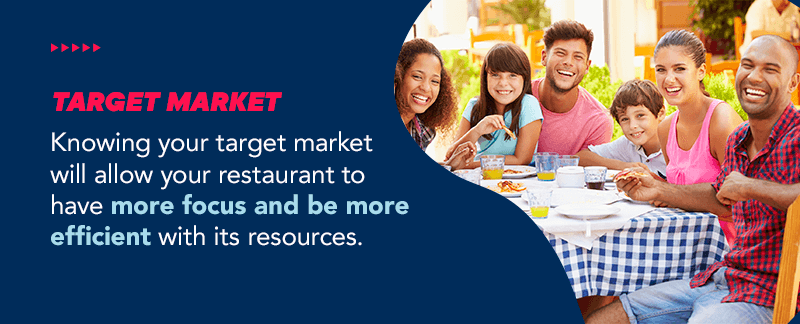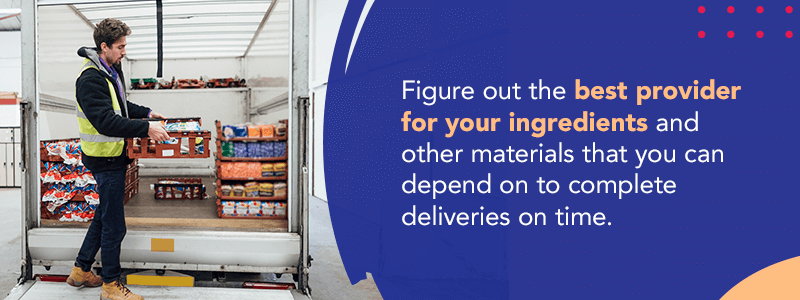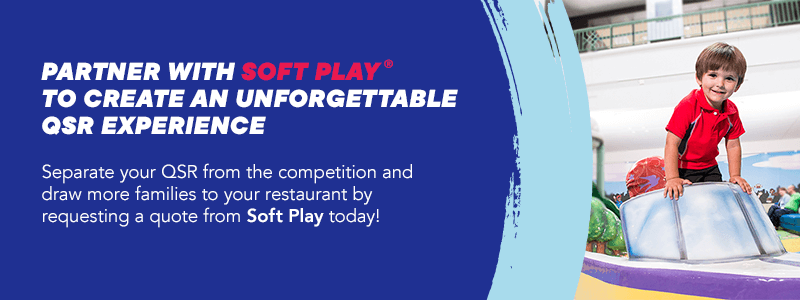Do you have the perfect business idea for a quick-service restaurant (QSR)? Now may be the time to finally bring your restaurant dreams to life. Although breaking into the restaurant industry takes some effort, a unique QSR concept with a solid business plan can win you a loyal customer base.
This ultimate QSR guide will tell you everything you need to know about starting a QSR. Discover the differences in fast food versus fast-casual, how to write a business plan, key financial considerations, effective marketing strategies and more. Learn how to start a quick-service restaurant and ensure its success below!
Table of Contents
- Create a Business Plan
- Evaluate Your Finances
- Decide What Makes Your QSR Special
- Finalize Your Choice
- Design a Marketing Strategy
- Partner with Soft Play to Create an Unforgettable QSR Experience
Create a Business Plan
A business plan is an essential first step toward opening up your restaurant. Coming up with a solid business plan will serve as the foundation of your restaurant’s operations and set you up for success.
Choose Your Restaurant Style
Before you can develop a sound business plan, you need to decide what kind of restaurant you’re trying to construct. Figuring out your overarching concept first will give you a sense of direction for mapping out the details of your restaurant experience. To choose the restaurant style that’s best for you, you’ll need to understand the difference between quick-service and fast-casual.
A quick-service restaurant or QSR is the official industry term for a fast-food establishment. QSRs generally have limited menus and hardly ever provide table service. The food they offer tends to consists of convenient options like handheld sandwiches, wraps, burritos and some types of salad.
The ambiance of a QSR is largely functional and provides some seating, although many customers choose to order their food to go. While fast food is popular for its rapid service and convenience, many fast-food restaurant chains have copied each other and saturated the market with look-alike QSRs. Nowadays, more and more consumers have been turning to fast-casual restaurants for a bit more variety.

A fast-casual restaurant also focuses on creating a more upscale setting with more sophisticated or trendy interior designs. Choosing whether your restaurant will be more focused on ambiance and menu variety or convenience and value will help you decide between starting a fast-casual or quick-service restaurant.
Pick a Business Plan Format
When it comes to crafting a business plan for your restaurant, there’s no one way to do it. Instead, your plan should suit your business and your needs. Most business plans can be categorized as traditional — the more common option with more details and a standardized structure — or lean startup.
The traditional business plan format might be the best fit for you if you’re highly detail-oriented.

When you start to write your business plan, feel free to use relevant parts for your restaurant and its specific needs instead of sticking with a strict business plan outline. In general, here’s what to include with your traditional business plan format:
- Executive summary: This portion briefly summarizes what your restaurant idea is and explains how it will succeed. Here, you’ll put your mission statement and information about your restaurant’s location, leadership team and employees. If you plan on asking for financing, put your financial details and growth plans here, too.
- Business description: This section is where you can go into a bit more detail about what your restaurant is and how it will operate.
- Industry analysis: Demonstrate that you’ve done your research and understand the market you’re getting into, along with how your restaurant will stand out from its competitors.
- Management structure: Explain the structure of your restaurant and who will lead it, including the roles of its owners, investors and managers.
- Service offerings: Describe what kind of food your restaurant will serve and specific menu options. Include how the experience at your restaurant will benefit the average consumer.
- Marketing plans: This portion describes how you plan on attracting and retaining customers.
- Funding needs: If you need to ask for funding, use this section to outline your restaurant’s funding requirements. Be clear about how much funding you need and what you’ll use the money for, such as salaries, bills, equipment and materials. Include specifics about whether you want a loan or will give shareholders stock, the terms you’d like and how many years your request covers.
- Financial projections: This additional information can add to your funding request with more precise financial projections and how successful you estimate your restaurant will be.
- Appendix: Put any other supplemental documents here, such as product pictures, resumes, letters of reference, credit histories, permits and licenses.
On the other hand, a lean startup plan allows you to explain and start your restaurant a bit more quickly. If your restaurant concept is relatively simple or you plan on regularly changing and refining your business plan, a lean startup format may be the right choice for you.
Essentially, a lean startup format is a chart that uses only a few elements to describe your restaurant’s value proposition, customers, finances and infrastructure. This format helps you effectively and efficiently convey the fundamental facts about your proposed restaurant.
A lean startup format will require the following components:
- Partnerships: Make a note of any key suppliers, manufacturers or other strategic partners you’ll work with to run your restaurant.
- Activities: Show how your restaurant will separate itself from other restaurants by highlighting what makes it special.
- Resources: Outline any resources you’ll use to create a valuable customer experience. This section should include details like your staff, capital and menu items.
- Value proposition: Here is where you’ll make a clear and compelling case about why your restaurant brings something unique to the market.
- Customer engagement and relationships: Explain how consumers will interact with your restaurant. Talk about the customer experience from the time they place their order to exiting the restaurant.
- Customer demographics: Discuss the details of your target market and who your restaurant will cater to.
- Customer communication: Make a list of the top ways you’ll communicate with your customers. Include a mix of channels that you can optimize over time.
- Cost structure: Define your restaurant’s strategies for maximizing its value and reducing costs.
- Revenue streams: Clearly explain how your restaurant will make money, draw customers and survive in the food service market.
Evaluate Your Finances
Evaluating your finances is a huge component of starting a restaurant and figuring out your business plan. Once you have the basic financial section of your business plan worked out, you can dive into the specifics of your profit, expenses, funding, liquid capital and budgeting. Calculating the specifics of these costs and incomes will help you manage your money well and keep your restaurant in business.
Secure Your Funding
Funding is one of the most important aspects of starting a restaurant. Where the majority of your funding comes from can also shape the way you structure and run your QSR. Here are your main three options for funding your dream restaurant:
Self-funding: If you’re in a financially secure enough position, you can fund your QSR on your own. By drawing on your own savings, capital from loved ones or tapping into your 401k, you can produce the money needed to launch a QSR. Self-funding allows you to maintain total control over your QSR but also means you take on all of the financial risk yourself.
- Getting investors: If you can’t fund your QSR on your own, you can get venture capital from investors. To obtain an investor, you’ll need to find a viable candidate, share your business plan with them and work out the terms of your partnership. Then you’ll be ready to receive your investment.
- Applying for loans: Many small businesses, such as local restaurants, apply for a loan to get started. To acquire a loan, you’ll have to present your business plan and financial projections to the bank or credit union. Once you make your convincing case, you’ll receive the loan and be ready to start your QSR.
Consider Your Costs
Whether you’re preparing to pitch your restaurant’s business plan to potential investors or have already secured your funding, you need to think through what the money your restaurant makes will go toward. Listing out your expenses will give you a clearer picture of how much revenue your restaurant needs to generate to break even and how much profit you’re likely to end up with.
Here are five key expenses to consider:
- Upfront costs: Of course, you’ll need to take your restaurant’s food and supply chain costs into account. How much will ingredients and serving supplies cost you on a weekly basis?
- Licenses and permits: You’ll need to factor in the cost of a business license and potentially a liquor license if you plan on serving any alcohol at your restaurant.
- The space: Will you be leasing your restaurant space or buying it outright? If you’re a new restaurant owner, you may want to consider leasing, which grants you more leeway for other major investments.
- Your staff: Think about how many staff members your restaurant will need and how much you can afford to pay each of them.
- Technology and appliances: A successful restaurant needs a variety of kitchen appliances, such as walk-in freezers, industrial ovens and refrigerators, along with technology like restaurant management software. With a high-quality point of sale (POS) system, you’ll be able to improve your restaurant’s profitability by saving time, cutting costs, organizing online ordering and evaluating menu item analytics.
Estimate Your Sales
Once you have a better grasp of how much your restaurant will need to spend each month to stay open, you can factor in your available funding to come up with a sound budget. List out how many investors you have and how much financial support you can rely on each of them to provide. You’ll also want to calculate your restaurant’s liquid capital, which includes any assets held as money, such as bank deposits, cash balances and money market investments.
While investors can help get your restaurant off the ground, you will mainly be relying on sales to keep your restaurant in business. Come up with a realistic projection of how much money your restaurant will bring in each month for an accurate depiction of your profit margin. Be as precise as possible by factoring in variables like holidays, local festivals, changing seasons and other factors.
Set a Budget
After thinking through all of your restaurant’s expenses, financial backing and revenue streams, you’ll be ready to create a budget.

If you can’t get your budget to balance, make adjustments to decrease your costs, increase your sales or both. For example, you may need to find a different supplier to get less expensive ingredients or up your marketing campaign to convert more customers. Ultimately, you will want to create a budget with static costs that allows your profit to steadily grow.
Decide What Makes Your QSR Special
Consistently making a large profit depends on retaining repeat customers and building a client base. To earn customer loyalty and secure their business, you will need to make your QSR stand out from other restaurants on the market. You will need to figure out a trademark feature that differentiates your restaurant from its hundreds of thousands of competitors by giving you a unique edge.
Your QSR will be most successful if you focus on doing one thing extremely well as opposed to doing several things relatively well. Although many people think expanding their menu is the solution to bringing in more customers, choosing a particular aspect of your restaurant to concentrate on will help you maintain a standard of excellence and separate your restaurant from other dining establishments.
Keep in mind, you can’t please everyone, so it’s best to zero in on your target market and cater to them.

A modern indoor playground will make dining at your QSR an unforgettable experience for families and keep drawing them back time and time again. You can make your restaurant’s play area extra memorable by sticking with a fun theme or bright color scheme. Getting indoor playground equipment with customized branding will also help your QSR stand out.
Whatever you choose as your QSR specialty, make sure it’s family-friendly and a dining experience customers can’t get anywhere else.
Finalize Your Choices
Once you’ve figured out the business plan, financial backing and special draw of your QSR, you’ll be ready to nail down the details of your restaurant. Before you can open your doors for business, you need to finalize these five decisions:
1. Target Market
Knowing your target market will allow your restaurant to have more focus and be more efficient with its resources.

Due to the fast and convenient nature of QSRs, the two demographic groups that generally bring the most revenue are parents and millennials. Both of these groups have a lot of responsibilities on their plate and just want quick, easy and delicious dinners. Concentrating on winning these two groups will set your QSR on the right track.
2. Location
Location is critical when it comes to starting a restaurant. Try to position your QSR in a densely populated area that’s close to members of your target market. Ensuring your restaurant is highly visible and accessible for your target demographics will attract more customers and generate more business.
3. Menu Items
Developing a tight list of delicious menu items is the foundation of your QSR’s success. Pick a focal point of foods that make sense together, appeal to your target market and align with your restaurant’s brand. Simplify your core ingredients to maximize your menu expertise, save time, eliminate waste and cut costs.
4. Equipment and Raw Materials
Once you know what you’ll be cooking, you can make decisions regarding the kitchen equipment and raw materials your QSR will need. Your restaurant’s kitchen will need to have the right industrial-sized equipment and appliances to support putting out mass quantities of your menu items along with space to store ingredients.
Figure out the best provider for your ingredients and other materials that you can depend on to complete deliveries on time.

5. Staff
Finally, you’ll need people to help you run your QSR. You will need a couple of chefs to help produce your restaurant’s delicious food and a few managers to oversee your restaurant’s daily operations. Additional staff members can help prep ingredients, serve customers and keep the dining areas clean. Along with these essential staff members, consider whether you’ll need a delivery team or a third-party delivery partner.
Design a Marketing Strategy
Once you’ve settled on who your target audience is and the details of what your QSR will offer, you can come up with the most effective marketing strategy. Designing a marketing strategy involves shaping the identity of your restaurant and creating a recognizable brand.
Your QSR’s brand includes its name, logo, color scheme, aesthetics, tagline, mission statement, values and overarching narrative. You will want to mold your restaurant’s brand to suit your target audience’s tastes. Meeting the expectations and values of your target market will make consumers more inclined to choose your QSR over others.
To get customers familiar with your QSR’s brand, you will need an excellent marketing campaign. Your marketing efforts must clearly communicate your brand message to your target market if you want to convince them your QSR is worth checking out. The following three marketing tactics are effective ways of reaching members of your target audience and converting them into loyal customers.
1. Social Media Campaigns
Social media platforms are perfect for advertising your QSR because they are visually driven and reach a broad audience. Depending on your target demographic groups, your QSR might be better suited for Instagram, Facebook, Twitter or TikTok. The best part about social media marketing is that creating an account is free, making advertising your brand online effective and affordable.
2. Email Marketing

3. Customer Review Sites
In the digital world, customer review sites are equivalent to word-of-mouth marketing. Encouraging your regular customers to leave positive reviews about your QSR online will boost your brand’s reputation. Do your best to respond to any negative comments quickly to demonstrate how much you care about resolving customer complaints and your commitment to serving customers well.
Partner With Soft Play® to Create an Unforgettable QSR Experience
If you’re ready to open a memorable QSR that appeals to parents, partner with Soft Play to choose the best indoor play pieces for your restaurant. Soft Play offers a wide variety of restaurant play area equipment that can be customized to fit within any space and budget. We also provide a free design consultation so you can get a clear picture of what your QSR’s play area will look like.
Separate your QSR from the competition and draw more families to your restaurant by requesting a quote from Soft Play today!



 Self-funding: If you’re in a financially secure enough position, you can fund your QSR on your own. By drawing on your own savings, capital from loved ones or tapping into your 401k, you can produce the money needed to launch a QSR. Self-funding allows you to maintain total control over your QSR but also means you take on all of the financial risk yourself.
Self-funding: If you’re in a financially secure enough position, you can fund your QSR on your own. By drawing on your own savings, capital from loved ones or tapping into your 401k, you can produce the money needed to launch a QSR. Self-funding allows you to maintain total control over your QSR but also means you take on all of the financial risk yourself.
